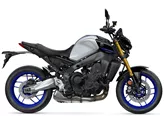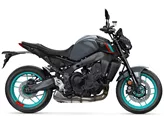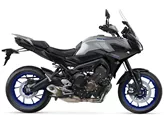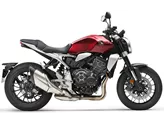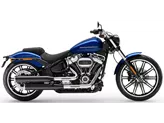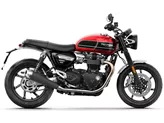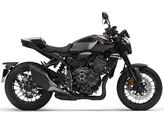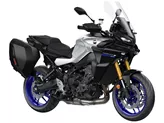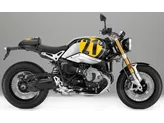Kawasaki Z900 RS 2018 vs. Yamaha MT-09 2013

Kawasaki Z900 RS 2018

Yamaha MT-09 2013
Overview - Kawasaki Z900 RS 2018 vs Yamaha MT-09 2013
When comparing the Kawasaki Z900 RS 2018 and the Yamaha MT-09 2013, there are several factors to consider.
In terms of engine specifications, both bikes have an in-line engine type. However, the Kawasaki Z900 RS has a slightly lower engine power of 111 HP compared to the Yamaha MT-09's 115 HP. The torque on the Kawasaki is higher at 98.6 Nm, while the Yamaha has a torque of 87.5 Nm. The Kawasaki has four cylinders and a displacement of 948 ccm, while the Yamaha has three cylinders and a displacement of 847 ccm.
In terms of suspension, the Kawasaki Z900 RS has an upside-down telescopic fork front suspension, while the Yamaha MT-09 has a telescopic fork front suspension.

Kawasaki Z900 RS 2018
In terms of chassis, the Kawasaki Z900 RS has a steel frame, while the Yamaha MT-09 has an aluminum frame. The Kawasaki has a tubular frame type, while the Yamaha has a twin tube frame type.
Both bikes have double disk front brakes and the same tire dimensions, with a front tire width of 120 mm and a rear tire width of 180 mm. They also both have a 17-inch front and rear tire diameter.
In terms of dimensions and weights, the Kawasaki Z900 RS has a longer wheelbase of 1470 mm compared to the Yamaha MT-09's 1440 mm. The seat height on the Kawasaki is higher at 835 mm, while the Yamaha has a seat height of 815 mm. The Kawasaki is also heavier, with a kerb weight (with ABS) of 215 kg compared to the Yamaha's 191 kg. The Kawasaki has a larger fuel tank capacity of 17 liters, while the Yamaha has a capacity of 14 liters.

Yamaha MT-09 2013
When it comes to strengths, the Kawasaki Z900 RS has a powerful and smooth engine, good looks, a comfortable seating position, and balanced handling. It is also described as easy to ride and not nervous or ponderous. On the other hand, the Yamaha MT-09 is praised for its reasonable price and powerful engine.
In terms of weaknesses, the Kawasaki Z900 RS does not have a shift assistant, making gear shifting less convenient. It is also heavier than other retro bikes in its class, which may affect maneuverability. Some riders find the seat a little too soft on long tours, and there is no wind protection. The Yamaha MT-09 has a hard chassis, which may result in a less comfortable ride. Additionally, it has a higher fuel consumption compared to the Kawasaki.
Overall, both bikes have their own strengths and weaknesses, and the choice between them will depend on individual preferences and priorities.
Technical Specifications Kawasaki Z900 RS 2018 compared to Yamaha MT-09 2013
Pros and Cons in comparison
Pros and Cons in comparison
Kawasaki Z900 RS 2018

Its four-cylinder is silky smooth while delivering enough power to make you grin under your helmet. It is also very easy to move, which should make it a great commuter bike in everyday life and serve as an iconic fun bike at the weekend. The looks find the perfect straddle of classic design and modern details to form a coherent retro package that is also a worthy tribute to Kawasaki history. It's a great naked bike with a snazzy look.
Yamaha MT-09 2013

The start is frightening - abandonment of 1st gear.
Price Comparison Avarage Market Price Kawasaki Z900 RS vs Yamaha MT-09
There are a few key differences between a Kawasaki Z900 RS 2018 and a Yamaha MT-09 2013. There are the same number of bikes of both models available on the 1000PS.de marketplace, specifically 28. It takes less time to sell a Yamaha MT-09 with 52 days compared to 154 days for the Kawasaki Z900 RS. Since model year 2018 1000PS.de editors have written 26 reviews for the Kawasaki Z900 RS and 57 reviews for the Yamaha MT-09 since model year 2013. The first review for the Kawasaki Z900 RS was published on 9/6/2017 and now has more than 63,700 views. This compares to more than 39,900 views for the first review on Yamaha MT-09 published on 6/10/2013.


